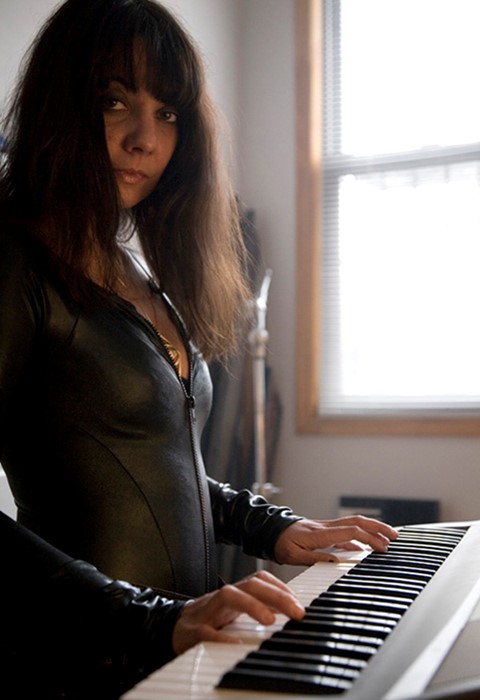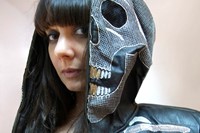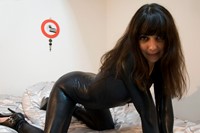It’s hard to imagine New York’s recent downtown art scene without Lizzi Bougatsos on the prowl. The Yoko-inspired frontwoman of the avant-garde dance band Gang Gang Dance has gained a reputation for pushing boundaries and making noise, and for most
It’s hard to imagine New York’s recent downtown art scene without Lizzi Bougatsos on the prowl. The Yoko-inspired frontwoman of the avant-garde dance band Gang Gang Dance has gained a reputation for pushing boundaries and making noise, and for most of the last decade she’s been a fixture on stage, at clubs, galleries, house parties, and outré salons as part of the generation of artists who left their mark on the city in the years following 9/11. Although it really wasn’t until her band’s 2008 album, Saint Dymphna, that the group began getting wider attention outside the close-knit art circles from which they emerged, they had already gained a sort of quasi-cult status among cognoscenti and hipster alike that had sealed their place in the lore of the era.
Her band’s sound, which is driven by free-range electronica, deep percussion, and Lizzi’s howling, wailing voice has always been hard to classify – which explains, in part, both their cool-as-shit persona and their lack of broad appeal. Indeed, the recent history of Gang Gang Dance has been about how to make that signature sound more accessible, more “pop”, without losing its jagged soul. Which is more or less the challenge of any outer-edge artist that decides it might be nice to make a living. The latest effort in that attempt is this month’s new release, Eye Contact, which delivers more genre-styled songs amid a few paeans to earlier noisemaking.
Visiting her last week at her Chinatown apartment and studio I’m not surprised to find two rooms full of her belongings strewn everywhere. Admittedly, Lizzi likes it this way. She finds comfort in chaos the way some people like sofas and cushions. After pouring me a cup of coffee she invites me to have a look around and, stepping over and around clothes, bags, suitcases, musical instruments, paintings and frames, I look for a few good spots amid the whorl of her life to take a handful of portraits. The only truly tidy spot is her bed, all perfectly made up with its tufted satin silver bedspread. Shooting her there, and a few other spots around her place, we also chat about music, art, her creative process, and, of course, chaos.
You’ve said that chaos plays an important part in your creative process. What is it about chaos, or the idea of it, that inspires you and engages your process?
I love chaos. I try to embrace it in my style, my apartment. I pile on jewels, mix and match, go against the grain; ‘no rules’ usually creates a refreshing look. There's also something about slewn books everywhere or spices open on my kitchen countertops that gives me comfort at home. I like a clean, organised chaos. Making order out of it is always very satisfying for me.
You mentioned the challenges of working in various art forms at once, in your case mainly art and music, and how difficult it can be to switch gears from one to the other – as well as between projects! Can you expand on this; I find this tension between multiple creative impulses and the effort to reconcile them very interesting...
Switching between art and music has always been a challenge for me, especially when a record is coming out – press and touring take up a lot of time. I usually need a month or two to get back into the ‘making art’ zone or even to be able walk the streets to come up with ideas. My gallerist helps me gather materials or with deadlines when I'm on the road so the pieces can come to fruition easier. I do dream of the day I can concentrate on oil paintings somewhere tropical, but right now I'm spending more time writing songs, book ideas and working on and rehearsing on my performances.
How do those two sides inform and inspire each other? How does art help your music and music help your art?
Conversations I have with people or things I hear inspire my song writing. Sometimes it's an event that will hit me like a rock and hold me down real heavy that will make me disappear for days inside myself. I get really turned off by the "industry" of what surrounds artists in music, so unless it's creative or fun, I tend to shy away from it. Sometimes a really bad show will inspire my art making, my response will come out in an artwork. It's usually making fun of a band that's playing the game too hard. I can't help but visualise it. I can see through art and music that’s not genuine.
On the new album, I’m really loving Glass Jar, which opens up the album in this mystical cadence and then swells into a cacophony of percussion and movement. It’s an impressive and commanding piece right out of the gate. How did that song come about?
I was listening to a lot of Alice Coltrane and my old standbys like Tekitha (who sang on some Wu Tang albums and her own), Nina Simone for the sort of "crying" inspiration for the intro to Glass Jar. My vision to create these soulful wails really of pain and suffering, yet it came out through my drumming rather than my voice. It took a more Pharaoh Saunders style. The other lyrics came from my Native American roots, how my grandpa would paint plaques of the afterlife. There were tunnels of where the body goes, many colours, and objects of nature, solar and planetary images. This became for me how people would come back to me when they left the physical earth. Almost the idea that a person can never leave you. One is always safe and loved.
Are you working on any new projects now we should know about?
I have a long overdue book called SOLD OUT PUSSY that Opening Ceremony and Chloë Sevigny are putting out. For June, I'll have some work at Art Basel and Half Gallery in Tokyo.
What music collaboration, as improbable or impossible as it might be, would you have most wanted to see happen in music history?
Gang Gang and Jay-Z. Hands down. Empire State Unification. This would be the ultimate.
Gang Gang Dance's new album, Eye Contact, is released today.



